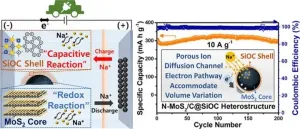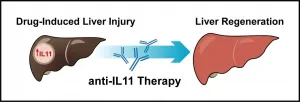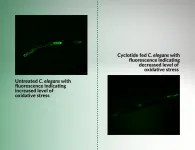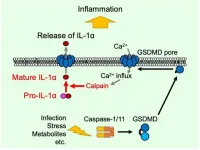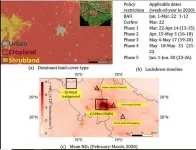Imaging at the tip of a needle
2021-06-18
(Press-News.org) Scientists have developed a new technique that could revolutionise medical imaging procedures using light.
A team of physicists, led by Dr David Phillips from the University of Exeter, have pioneered a new way in which to control light that has been scrambled by passage through a single hair-thin strand of optical fibre. These ultra-thin fibres hold much promise for the next generation of medical endoscopes - enabling high-resolution imaging deep inside the body at the tip of a needle.
Conventional endoscopes are millimetres wide and have limited resolution - so cannot be used to inspect individual cells. Single optical fibres are approximately 10x narrower and can enable much higher-resolution imaging - enough to examine the features of individual cells directly inside living tissue. It is normally only possible to view cells once they have been taken outside the body and placed in a microscope.
The catch is that we can't directly look through optical fibres, as they scramble the light sent through them. This problem can be solved by first calibrating an optical fibre to understand how it blurs images, and then using this calibration information as a key to decipher images from the scrambled light. Earlier this year, Dr Phillips' group developed a way to measure this key extremely rapidly, in collaboration with researchers from Boston University in the USA, and the Liebniz Institute of Photonic Technologies in Germany [paper: Compressively sampling the optical transmission matrix of a multimode fibre, published in Light: Science and Applications, April 21st 2021].
However, the measured key is very fragile, and easily changes if the fibre bends or twists, rendering deployment of this technology in real clinical settings currently very challenging. To overcome this problem, the Exeter based team have now developed a new way to keep track of how the image unscrambling key changes while the fibre is in use. This provides a way to maintain high resolution imaging even as a single fibre based micro-endoscope flexes. The researchers achieved this by borrowing a concept used in astronomy to see through atmospheric turbulence and applying it to look through optical fibres. The method relies on a 'guide-star' - which in their case is a small brightly fluorescing particle on the end of the fibre. Light from the guide-star encodes how the key changes when the fibre bends, thus ensuring imaging is not disrupted.
This is a key advance for the development of flexible ultra-thin endoscopes. Such imaging devices could be used to guide biopsy needles to the right place, and help identify diseased cells within the body.
Dr Phillips, an Associate Professor in the Physics and Astronomy department at the University of Exeter, said: "We hope that our work brings the visualisation of sub-cellular processes deep inside the body a step closer to reality - and helps to translate this technology from the lab to the clinic."
The latest work is in collaboration with researchers at the Liebniz Institute of Photonic Technologies in Germany, and the Brno Insititute of Scientific Instruments in the Czech Republic. The project was made possible with funding from the Royal Academy of Engineering and the Royal Society in the UK, the European Research Council, and the Chinese Scholarship Council.
Memory effect assisted imaging through multimode optical fibres is published in Nature Communications on Friday, June 18th 2021
INFORMATION:
[Attachments] See images for this press release:

ELSE PRESS RELEASES FROM THIS DATE:
2021-06-18
Various automobile companies are preparing to shift from internal combustion (IC) engine vehicles to electric vehicles (EVs). However, due to higher cost, EVs are not as easily accessible to consumers; hence, several governments are subsidizing EVs to promote sales. For EV costs to compete with those of IC engine vehicles, their batteries, which account for about 30% of their cost, must be more economical than that of IC-based vehicles.
The Korea Institute of Science and Technology (KIST) has announced that Dr. Sang-Ok Kim's team at the Center for Energy Storage Research had developed a novel, high-performance, economical anode material for use in sodium-ion secondary batteries, which are ...
2021-06-18
New classes of drugs are biologic disease-modifying anti-rheumatic drugs (bDMARDs) and Januskinase inhibitors (JAKi). At the 2021 EULAR congress, Strangfeld and colleagues shared new data assessing the effects of these medications on the risk of serious infections in elderly people with RA. RA is an inflammatory autoimmune disease that causes pain, swelling, and stiffness in the joints, but it also affects other organ systems through underlying systemic inflammation, causing for example cardiovascular diseases or fatigue.
RABBIT is a prospective, observational cohort study in Germany. ...
2021-06-18
The loss of a loved one can be a defining moment, even in the animal world. In chimpanzees, for example, individuals whose mothers die when they are young are smaller than their counterparts, reproduce less and are also more likely to die at a young age. But why? To find out, an international research team* led by a CNRS researcher** studied the short- and long-term effects of maternal loss on the stress levels of orphaned chimpanzees over a 19-year period. By comparing the levels of a stress hormone marker, cortisol, between young and adult orphans and non-orphans, the scientists found that young ...
2021-06-18
The body is well protected against invading pathogens by barriers such as the skin. But if you injure yourself and break your skin, pathogens can easily enter your body through the wound and cause severe infections. If this occurs, the innate immune system takes over the first rapid defense with an effective arsenal of cellular weapons infiltrating the wounded tissue in large numbers. As one of the first cell types on the spot, neutrophil granulocytes are recruited within few hours from the bloodstream to the infection site to eliminate potential microbial invaders.
Swarming against infections
"Neutrophils are very efficient in hunting and ...
2021-06-18
Singapore, 18 Jun 2021 - Scientists at Duke-NUS Medical School and National Heart Centre Singapore (NHCS), in collaboration with colleagues in Singapore and the UK, have shown that the human form of the signalling protein interleukin 11 (IL-11) has a damaging effect on human liver cells--overturning a prior hypothesis that it could help livers damaged by paracetamol poisoning. The finding, published last week in Science Translational Medicine, suggests that blocking IL-11 signalling could have a restorative effect.
Paracetamol, also called acetaminophen, is a widely available over-the-counter painkiller, and an overdose can lead to serious liver damage and even death. It is the most common pharmaceutical ...
2021-06-18
Most of us have heard of Alzheimer's disease, a neurodegenerative disorder marked by brain cell death and the shrinking of the brain. It is the most common cause of dementia and cognitive impairment, which typically have a devastating effect on a person's quality of life. There is still no cure for Alzheimer's.
One way of tackling the progression of Alzheimer's disease (AD) is to prevent the underlying adverse changes in the brain. A team of researchers from the National Centre for Biological Sciences (NCBS) has recently published a study in the Journal of Medicinal Chemistry, dedicated to neuroprotection against these toxic changes. They used tiny free-living soil worms --called Caenorhabditis elegans--and the often-ornamental ...
2021-06-18
Kanazawa, Japan - Interluekin-1α (IL-1α) is an important part of the immune response, but until now it has been unclear how this molecule is processed from its precursor, pro-IL-1α, and exits the cell during inflammasome activation. Now, researchers from Japan have found that gasdermin D, a protein that was already known to mediate pyroptosis, a form of regulated cell death, plays a crucial role in the maturation and release of IL-1α.
In a study published in March in Cell Reports, researchers from Kanazawa University report that, when the ...
2021-06-18
COVID-19 has changed the world in unimaginable ways. Some have even been positive, with new vaccines developed in record time. Even the extraordinary lockdowns, which have had severe effects on movement and commerce, have had beneficial effects on the environment and therefore, ironically, on health. Studies from all around the world, including China, Europe and India, have found major drops in the level of air pollution. However, to fully understand the impact of anthropogenic causes, it is important to separate them from natural events in the atmosphere like wind flow.
To demonstrate this point, a new study by researchers at the Research Institute for Humanity and Nature, Japan, uses satellite data and mathematical modeling to explain just ...
2021-06-18
Identifying the causes of human neurodegenerative diseases is a global research priority, warranting frequent reviews of the accumulating knowledge. In doing just that, biologists from the Plant Physiology Laboratory at the University of Guam and neuroscientists from the Experimental Medicine Program at The University of British Columbia have published an update on the reputed environmental toxins that have been suspected of being involved in mammal neurodegeneration. Their summary was published in April in the book Spectrums of Amyotrophic Lateral Sclerosis, which is available online ...
2021-06-18
According to a recent Finnish study, higher levels of moderate and vigorous physical activity can curb arterial stiffening already in childhood. However, sedentary time or aerobic fitness were not linked to arterial health. The results, based on the ongoing Physical Activity and Nutrition in Children (PANIC) Study conducted at the University of Eastern Finland, were published in the Journal of Sports Sciences. The study was made in collaboration among researchers from the University of Jyväskylä, University of Eastern Finland, the Norwegian School of Sport sciences, and the University of Cambridge.
Arterial stiffening predisposes to heart diseases, ...
LAST 30 PRESS RELEASES:
[Press-News.org] Imaging at the tip of a needle

